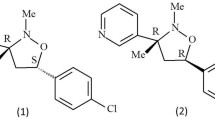Abstract
Purothionins (PTHs) and hordothionins (HTHs) were purified by cation-exchange chromatography from petroleum-ether extracts of wheat and barley flour respectively. The HTHs could be separated into two fractions, HTH-1 and HTH-2. Radial diffusion assays and micro-plate broth dilution assays with a number of plant pathogenic bacteria showed that these proteins were toxic forClavibacter michiganensis subsp.michiganensis, the causal agent of bacterial canker on tomato,C. m. subsp.sepedonicus, the causal agent of ring rot on potato, andXanthomonas campestris pv.vesicatoria, the causal agent of a spot disease on tomato and pepper. Only minor differences in toxicity between PTHs and HTHs, and between HTH-1 and HTH-2, were detected. Minor differences in toxicity of these thionins were also detected for different strains of these bacteria. The use of these plant proteins for engineering bacterial disease resistance into solanaceous crops will be discussed.
Similar content being viewed by others
References
Anzai, H., Yoneyama, K. & Yamaguchi, I., 1989. Transgenic tobacco resistant to a bacterial disease by the detoxification of a pathogenic toxin. Molecular & General Genetics 219: 492–494.
Balls, A.K., Hale, W.S. & Harris, T.H., 1942. A crystalline protein obtained from a lipoprotein of wheat flour. Cereal Chemistry 19: 279–288.
Békés, F., 1975. A study of purothionin isolated from the petroleum ether extract of wheat fluor. Acta Alimentaria 6: 39–57.
Bohlmann, H., Clausen, S., Behnke, S., Giese, H., Hiller, C., Reimann-Philipp, U., Schrader, G., Barkholt, V. & Apel, K., 1988. Leaf-specific thionins of barley: A novel class of cell wall proteins toxic to plant-pathogenic fungi and possibly involved in the defence mechanism of plants. EMBO Journal 7: 1559–1565.
Bradford, M.M. 1976. A rapid and sensitive method for the quantitation of microgram quantities of protein utilizing the principle of protein-dye binding. Analytical Biochemistry 72: 248–254.
Castagnaro, A., Maraña, C., Carbonero, P. & García-Olmedo, F., 1992. Extreme divergence of a novel wheat thionin generated by a mutational burst specifically affecting the mature protein domain of the precursor. Journal of Molecular Biology 224:1003–1009.
De la Fuente-Martínez, J.M., Mosqueda-Cano, G., Alvarez-Morales, A. & Herrera-Estrella, L., 1992. Expression of a bacterial phaseolotoxin-resistant ornithyl transcarbamylase in transgenic tobacco confers resistance toPseudomonas syringae pv.phaseolicola. Bio/Technology 10: 905–909.
Ebrahim-Nesbat, F., Behnke, S., Kleinhofs, A. & Apel, K., 1989. Cultivar-related differences in the distribution of cell-wall-bound thionins in compatible and incompatible interactions between barley and powdery mildew. Planta 179: 203–210.
Fernandez de Caleya R., Gonzalez-Pascual, B., García-Olmedo, F. & Carbonero, P., 1972. Susceptibility of phytopathogenic bacteria to wheat purothioninsin vitro. Applied Microbiology 23: 998–1000.
Fisher, N., Redman, D.G. & Elton, G.A.H., 1968. Fractionation and characterization of purothionin. Cereal Chemistry 45: 48–57.
Florack, D.E.A., Visser, L., Van Vloten-Doting, L., Heidekamp, F. & Stiekema, W.J., 1990. Synthetic hordothionin genes as tools for bacterial disease resistance breeding. In: Dekkers, J.J., Van der Plas, H.C. & Vuijk, D.H. (Eds), Agricultural biotechnology in focus in the Netherlands, Pudoc, Wageningen. p. 39–46.
García-Olmedo, F., Rodriguez-Palenzuela, P., Hernández-Lucas, C., Ponz, F., Maraña, C., Carmona, M.J., Lopez-Fando, J., Fernandez, J.A. & Carbonero, P., 1989. The thionins: A protein family that includes purothionins, viscotoxins and crambins. Oxford Surveys of Plant Molecular & Cell Biology 6: 31–60.
Jones, B.L. & Mak, A.S., 1976. Amino acid sequences of the two α-purothionins of hexaploid wheat. Cereal Chemistry 54: 511–523.
McFarland, J. 1907. The nephelometer: An instrument for estimating the numbers of bacteria in suspensions used for calculating the opsonic index and for vaccines. Journal of the American Medical Association 49: 1176–1178.
Ohtani, S., Okada, T., Kagamiyama, H. & Yoshizumi, H., 1975. The amino acid sequence of purothionin A, a lethal toxic protein for brewer's yeasts from wheat. Agricultural and Biological Chemistry 39: 2269–2270.
Oka, T., Murata, Y., Nakanishi, T., Yoshizumi, H., Hayashida, H., Ohtsuki, Y., Toyoshima, K. & Hakura, A., 1992. Similarity, in molecular structure and function, between the plant toxin purothionin and the mammalian pore-forming proteins. Molecular Biology and Evolution 9: 707–715.
Okada, T. & Yoshizumi, H., 1973. The mode of action of toxic protein in wheat and barley on brewing yeast. Agricultural and Biological Chemistry 37: 2289–2294.
Redman, D.G. & Elton, G.A.H., 1969. Reduction and re-oxidation of the purothionins. Journal of the Science of Food and Agriculture 20: 546–549.
Redman, D.G. & Fisher, N., 1969. Purothionin analogues from barley flour. Journal of the Science of Food and Agriculture 20: 427–432.
Sawyer, R.L., 1984. Potatoes for the developing world. International Potato Center, Lima, Peru. 150 pp.
Stuart, L.S. & Harris, T.H., 1942. Bactericidal and fungicidal properties of a crystalline protein isolated from unbleached wheat flour. Cereal Chemistry 19: 288–300.
Swank, R.T. & Munkres, K.D., 1971. Molecular weight analysis of oligopeptides by electrophoresis in polyacrylamide gel with sodium dodecyl sulfate. Analytical Biochemistry 39: 462–477.
Towbin, H., Staehelin, T. & Gordon, J., 1979. Electrophoretic transfer of proteins from polyacrylamide gels to nitrocellulose sheets: procedure and some applications. Proceedings of the National Academy of Sciences of the USA 76: 4350–4354.
Author information
Authors and Affiliations
Rights and permissions
About this article
Cite this article
Florack, D.E.A., Visser, B., De Vries, P.M. et al. Analysis of the toxicity of purothionins and hordothionins for plant pathogenic bacteria. Netherlands Journal of Plant Pathology 99, 259–268 (1993). https://doi.org/10.1007/BF01974307
Accepted:
Issue Date:
DOI: https://doi.org/10.1007/BF01974307




